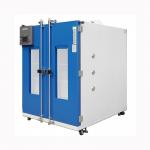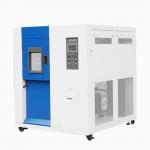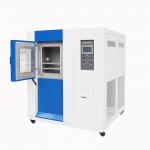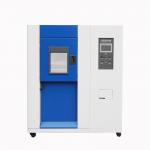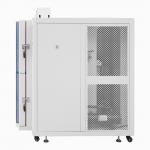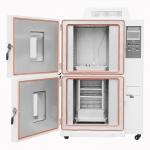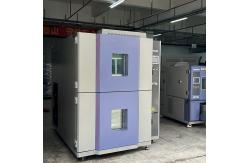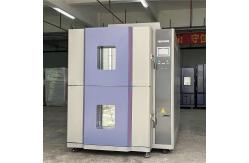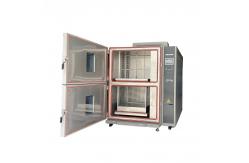In the highly demanding and critical realm of military and defense
equipment, the need for components and systems that can withstand
extreme and unpredictable conditions is non-negotiable. The Custom
Thermal Shock Chambers, meticulously designed to meet Military
Standard 202, Method 107 test standards, emerge as an essential
tool in safeguarding the integrity and performance of military
hardware. This custom-engineered thermal shock chamber is dedicated to
subjecting a diverse array of military-grade components and
assemblies to the exacting thermal shock testing protocol mandated
by Military Standard 202, Method 107. It serves defense
contractors, military research institutions, and equipment
manufacturers. The overarching goal is to evaluate the resilience
of components such as avionics circuitry, missile guidance systems,
communication equipment, and weaponry mechanisms under rapid and
severe temperature transitions. By faithfully replicating the
thermal shock scenarios that military equipment may encounter
during deployment, from arctic cold to desert heat and rapid
altitude changes, manufacturers can identify and rectify potential
weaknesses, optimize designs for maximum durability, and enhance
the overall mission-readiness and survivability of military assets. - Robust and Rugged Chamber Construction
- The chamber is constructed with heavy-duty, high-strength materials
that can endure the punishing forces and stresses associated with
military-standard testing. The walls are fabricated from thick,
heat-treated steel alloy, fortified with advanced thermal
insulation layers to minimize heat leakage and ensure precise
temperature control. The door is engineered with a redundant
sealing mechanism and a reinforced viewing window, allowing
operators to monitor the testing process without compromising the
chamber's integrity. The interior is designed with a modular
layout, facilitating the accommodation of variously sized and
shaped military components, and equipped with adjustable mounting
fixtures and racks for secure and uniform sample positioning.
- Precision Temperature Control and Cycling System
- Temperature Range and Cycling Capability: Capable of achieving an
extensive temperature range, typically from -75°C to +150°C. The
system can execute rapid and precise temperature cycling between
the hot and cold zones, with a transition time as brief as a few
seconds. This is crucial for mimicking the abrupt temperature
changes that military equipment may experience in the field, such
as during rapid ascents or descents in aircraft or exposure to
extreme environmental shifts. The temperature control is accurate
to within ±0.2°C, providing the level of precision required for
reliable and repeatable test results.
- Programmable Temperature Profiles: The chamber's control system
allows for the creation and execution of complex, custom
temperature profiles. Operators can define specific temperature
levels, dwell times in each zone, and the sequence and number of
thermal shock cycles to replicate a wide range of real-world
military operational scenarios. This flexibility enables
comprehensive testing of components under different
mission-critical conditions.
- Intuitive Control Panel and Data Acquisition Interface
- The control panel is designed for ease of use by military
technicians and engineers. It features a clear and intuitive
interface that enables effortless setting and adjustment of all
test parameters, including temperature, cycling times, and sample
identification. The panel also provides real-time displays of the
current temperature in both zones, the status of the testing
process, and any alarms or warnings. The chamber is integrated with
a sophisticated data acquisition system that records all relevant
test data. This includes detailed temperature histories, cycle
counts, and any observable changes in the physical, electrical, or
mechanical properties of the tested components. The data can be
stored in a secure, encrypted format in the chamber's built-in
memory or exported to external military-grade storage devices for
in-depth analysis and reporting. The system can also generate
comprehensive test reports in various standardized military
formats.
- Enhanced Safety and Security Features
- To ensure the safety of operators and the protection of sensitive
military test samples and the chamber itself, a comprehensive suite
of safety and security features is incorporated. These include
multiple layers of over-temperature and over-current protection,
emergency stop buttons with redundant circuitry, and advanced
alarms for any abnormal temperature fluctuations, equipment
malfunctions, or security breaches. The chamber is also equipped
with biometric access controls and intrusion detection systems to
prevent unauthorized access and safeguard classified testing
activities. Additionally, it has a self-contained fire suppression
system and proper ventilation and exhaust mechanisms to handle any
potentially hazardous gases or vapors that may be generated during
testing.
- Temperature Range and Accuracy
- The -75°C to +150°C temperature range with ±0.2°C accuracy offers
an extensive and precise testing envelope. Military components
often have strict temperature tolerance requirements due to their
exposure to diverse and harsh environments. For example, electronic
components in a fighter jet's avionics suite must function
flawlessly across a wide temperature spectrum. The accurate
temperature control ensures that the test conditions precisely
match the demands of Military Standard 202, Method 107, allowing
for a meticulous assessment of component performance and
reliability.
- Thermal Shock Cycle Parameters
- The chamber can be programmed to perform a highly customizable
number of thermal shock cycles, ranging from a few dozen to several
thousand, depending on the specific military equipment's
requirements and expected service life. The dwell time in each
temperature zone can be adjusted from milliseconds to hours,
enabling the simulation of a vast array of mission profiles. For
instance, a missile guidance system may need to withstand short,
intense thermal shock cycles during launch and flight, while a
communication relay station might experience longer, more gradual
temperature changes over an extended period.
- Testing Volume and Payload Capacity
- The chamber offers a flexible testing volume, typically ranging
from 3 m³ to 15 m³, to accommodate a wide variety of military
components and assemblies, from small circuit boards to large
weaponry subsystems. The payload capacity is designed to handle
heavy and bulky items, with a maximum capacity of up to several
tons, ensuring that even the most substantial military hardware can
be effectively tested.
- Data Sampling Frequency and Resolution
|
